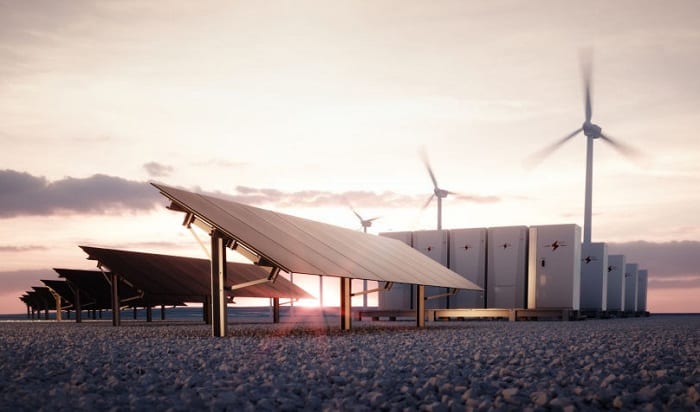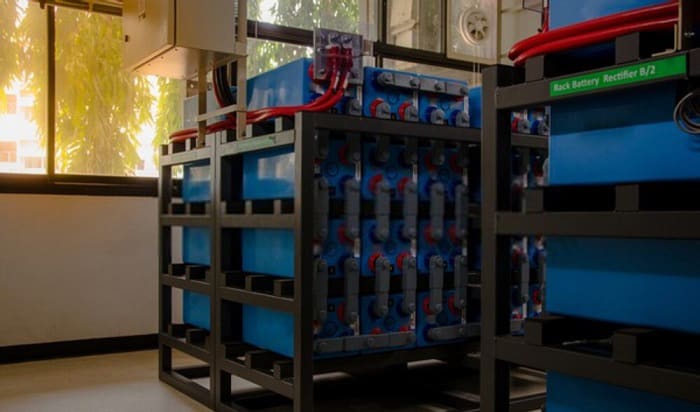Setting up a solar power system at home or in the workplace can be one of the best decisions you can make. You can significantly minimize your monthly electricity expenses while reducing carbon emissions with green and renewable power. But, the question is, how is solar energy stored?
In essence, there are three primary methods of saving solar energy for future consumption. Such methods include mechanical, battery, and thermal storage. Let’s go through the rest of this post to learn more about the different solar energy storage methods.
Table of Contents
The Components Needed for Solar Energy Storage
Fundamentally, solar storage systems call for several components to make them function as expected. While it’s true that there are plenty of variations that you could utilize, the fundamental components for any solar storage system include:
1. Batteries
Batteries are the core of your energy storage system. A couple of the most typical types of batteries are Lithium-Nickel-Manganese-Cobalt (NMC) and Lithium-Iron-Phosphate (LFP).
2. Solar Panels
These components enable you to charge the battery using a green and renewable form of energy. It is possible not to have solar panels for an energy storage system; nonetheless, solar panels are preferred.
Solar panels are of different types such as thin film, PERC, Polycrystalline, and Monocrystalline.
3. Critical Load Subpanel
This component refers to a device that figures out what will get powered if the grid stops working.
Did you know that most batteries are incapable of powering the entire household for an extended time? Hence, to prolong the amount of time the battery lasts during a power disruption, you may consider powering merely a few essential devices at home.
Basically, the critical load subpanel enables you to pick those critical loads, and solar installers must install this device properly for your battery’s capacity.
4. Inverters
These devices work by converting energy from alternating current to direct current and vice versa. Inverters are necessary because they transform the direct current energy from the solar panels and batteries into alternating current that is utilized at home.
At present, some solar panels and batteries now contain an integrated inverter in their components.
5. Other Vital Components
The other small components required to make your solar energy storage system work include circuit breakers, electrical conduits, AC and DC disconnects, cables, and fuses.
What’s more, switchgear, battery enclosures, mounting hardware, and safety equipment are necessary. The good news is that a few modern and leading storage systems contain mobile and software apps to offer additional control to the homeowner.
How is Solar Energy Stored?
The solar energy storage system can be divided into three main categories: mechanical, battery, and thermal. Let’s take a closer look at each method:
1. Mechanical Energy Storage
This method exploits the potential energy of an object to produce electricity. The process involves converting excess electrical energy into mechanical power, which is then converted back into electricity for future consumption.
The three unique mechanical energy storage systems include:
- Compressed Air
This method involves pumping compressed air into massive vessels, like tanks or underground formations. The air is dispensed to produce energy when necessary.
- Pumped Hydro
This process works by pumping the water up to a reservoir situated on top of turbine generators. This method enables the water to flow through the turbines to produce energy when there’s peak demand.
- Flywheel
This approach works by utilizing excess energy to spin a flywheel, which later provides power when required.
2. Battery Storage
You can also store solar energy in electrochemical batteries. When solar power is pumped into the battery, a chemical reaction among the battery parts saves energy. The reaction is overturned when the battery is discharged, enabling the current to get out of the battery.
Lithium-ion batteries are commonly utilized for solar applications. The delightful news is that the latest battery technology is growing rapidly, which will produce less expensive and more innovative battery storage solutions.
3. Thermal Storage
This storage system exploits different mediums to take in and retain heat coming from sunlight. Such mediums include molten salt and water. The heated medium is put in an insulated tank until energy is required, typically to boil water for power production.
Storing Solar Energy at Home
Solar storage systems at home come with lots of perks, such as decentralization of electrical generation, savings on electricity expenses, and resiliency.
It is all thanks to solar battery storage; countless homeowners can now delight in efficient and economical means to store solar energy.
At present, lithium-ion batteries are the most common option for residential solar energy storage. Such batteries are comparatively low-profile, inexpensive, and suitable for a vast array of requirements. Meanwhile, the other batteries usually available for home use are lead-acid and saltwater batteries.
So, how can you store power?
The solar battery units are set up in a bank in your home, and these are connected to your system. Due to this, you can set aside more bucks on electric bills since the system acquires power from the charged batteries before drawing directly from the grid.
Interestingly, this would be cost-effective if your utility’s electricity rates adhere to a variable time-of-use plan, varying throughout the day depending on the demand.
Thus, instead of getting credits for excess power through net metering, you’re in what is called “self-consumption,” which is an excellent means of enjoying more power savings.
Commercial Solar Energy Storage
Utility firms and other types of businesses usually have bigger budgets than ordinary households. This is why for commercial uses, thermal and mechanical storage systems are undoubtedly reasonable alternatives.
While the expenses for these storage methods are remarkably higher, they are adept at helping utilities sustain peak energy demands.
Heads Up: You might want to check out this video to delve into the detailed process of solar power storage:
What are the Advantages of Storing Solar Energy
Saving excess energy is vital to getting the most out of any solar power system. In the same way, this method can help in reducing more fossil fuel emissions and result in more efficient energy grids and expense savings.
A few of the advantages of solar energy include the following:
- Energy Resilience
It’s worth noting that the energy grid is susceptible to power outages and disruptions. This can be because of various factors, such as rugged weather conditions and wildfires.
Solar energy storage forms a shielding bubble during troublesome events by decentralizing where we acquire our energy from.
- Bridging the Gaps
Short-term energy storage enables a steady flow of energy in times of short disruptions in generators, like routine maintenance or passing clouds.
- Stabilizing Electric Loads
If it is not stored, you have to utilize electricity the moment it is produced. Energy storage enables excess production to be stored for later use. Storing excess energy enables your fixtures to remain lit at dusk or when the wind stops blowing.
In other words, energy storage enables an energy reservoir to be charged when production is at a peak and demand is low and then dispensed when production drops and demand increases.
Other Related Information
1. How long can solar energy be stored?
If solar energy is stored mechanically, it could last as long as the potential energy is sustained. As you might already know, there is energy lost in any energy transmission, and in a mechanical storage method, leaks often emerge during storage and dispensation.
The same thing applies to batteries. Typically, a regular solar battery will be able to hold a charge for one to five days.
2. How many solar batteries are required?
The storage capacity may differ remarkably based on your requirements. Apart from this, you need to consider your backup load, preferred storage capacity, and backup duration.
3. What’s the most economical solar battery option?
Nowadays, lead-acid batteries are deemed the most economical alternative for solar energy storage. Please keep in mind that they don’t last long and are not as efficient as other available alternatives.
Meanwhile, lithium-ion batteries provide the most outstanding value in terms of availability, service life, performance, and cost.
4. Do solar batteries last for an extended time?
Depending on the type of solar battery, regular solar batteries generally last for 15 to 30 years. Regular inspection and maintenance are required to ensure proper function, excellent performance, and longevity.
Final Thoughts
As a whole, the sun offers us an inexhaustible supply of renewable and green energy. With it, we don’t only enjoy more power usage, but we can also save more dollars in the future. However, harnessing this energy could be a severe challenge.
The pleasant news is that there are many options for residential and commercial storage that provide excellent solutions for saving solar energy.
Again, we’d like to reiterate the three primary methods of storing solar energy:
- mechanical storage – used primarily for commercial purposes
- battery storage – used chiefly for home applications
- thermal storage – usually utilized for commercial applications
Hopefully, this post was able to help you answer the question, “how is solar energy stored?

As the founder of the Avasolar team, I aspire to solve the problems for households in selecting, installing, and utilizing solar mechanical devices.



